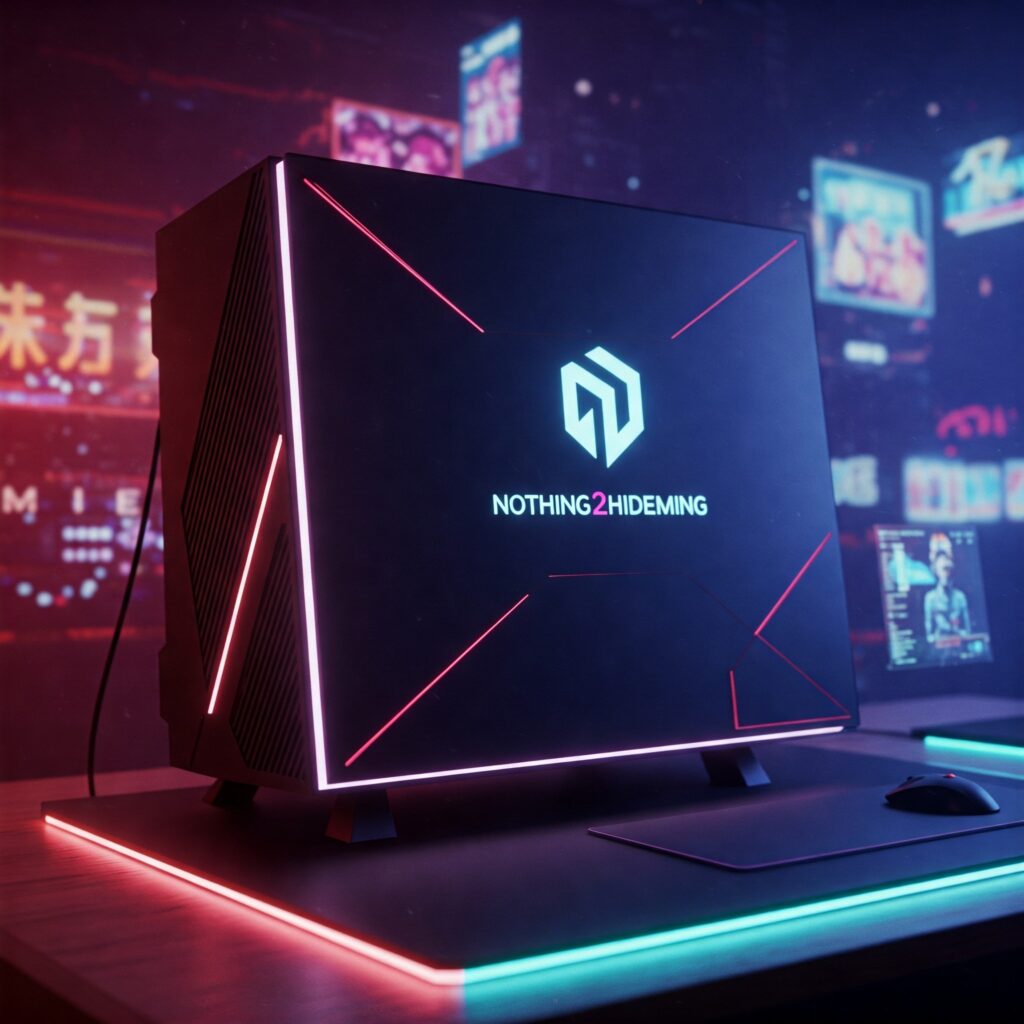🎮 Ultimate Guide to nothing2hidenet Gaming in 2025: Everything You Need to Know

Introduction
In a rapidly changing digital landscape, where data privacy and freedom of expression are at the heart of online experiences, nothing2hidenet gaming is emerging as a new frontier for gamers. Unlike traditional platforms that often rely on centralized servers and expose user data to potential surveillance or misuse, nothing2hidenet gaming is built on principles of anonymity, security, and player-driven ecosystems. In 2025, this gaming trend is no longer a fringe concept—it’s becoming a movement that redefines how we engage with virtual worlds.
Gaming has always been more than just entertainment. For millions of players worldwide, it’s a form of self-expression, social interaction, and creative exploration. However, the rise in concerns over data mining, censorship, and targeted harassment has led many to seek safer and more private alternatives. That’s where nothing2hidenet gaming comes in. By combining decentralized technology with anonymous networking protocols, it offers an environment where users can explore, compete, and collaborate without the fear of being tracked or monitored.
This comprehensive guide will walk you through what nothing2hidenet gaming is, how it works, which games thrive in this ecosystem, and what ethical and security implications you should consider. Whether you’re a privacy-conscious gamer, a developer curious about decentralized platforms, or just someone who wants to stay ahead of gaming trends, this article will provide everything you need to know.
Understanding nothing2hidenet Gaming
nothing2hidenet gaming isn’t just a term—it represents a philosophy that empowers users through privacy-first frameworks and decentralized systems. At its core, it refers to a gaming network built on anonymous access, where gamers participate in virtual worlds without revealing personal details. The name “nothing2hidenet” symbolizes a paradox: while players have nothing to hide, they also demand control over their digital identity, asserting their right to privacy in an increasingly monitored world.
Technologically, nothing2hidenet gaming leverages tools like peer-to-peer (P2P) networking, decentralized servers (often blockchain-based), end-to-end encryption, and TOR-like routing mechanisms. This tech stack ensures that player data is never stored in a single vulnerable location. It also minimizes the possibility of censorship or manipulation from corporate entities. Instead of traditional accounts tied to email addresses or phone numbers, these platforms might rely on wallet addresses, tokens, or anonymous identities.
One of the biggest distinctions between nothing2hidenet gaming and standard online games lies in ownership and control. In conventional games, players lease their experiences—servers can shut down, accounts can be banned, and digital items can be revoked. In contrast, decentralized gaming models built on nothing2hidenet principles give players true ownership over their assets and interactions. This shift not only changes how games are played but how communities are formed and how economies within those games evolve.
How to Access and Get Started with nothing2hidenet Gaming
Getting started with nothing2hidenet gaming might feel unfamiliar at first, especially if you’re used to platforms like Steam, Xbox Live, or PlayStation Network. The onboarding process usually begins with downloading a decentralized launcher or accessing a hidden service through privacy networks like TOR or I2P. Some platforms also offer downloadable clients that run directly from your device without installing spyware or trackers.
To start, users typically need a crypto wallet or a decentralized ID (DID). These IDs act as your in-game identity and wallet combined, allowing you to store currencies, game assets, and credentials without tying them to personal information. Unlike mainstream platforms where your activity is monitored, nothing2hidenet systems let you game freely without fear of your data being sold or exploited.
Once inside the ecosystem, the interface might feel more raw or minimalistic compared to glossy corporate platforms, but what it lacks in flair it makes up for in freedom. Most of these networks offer open-world games, sandbox experiences, or PvP environments with minimal moderation. Communication is often peer-encrypted, with chat logs stored locally or disappearing automatically.
Still, it’s important to exercise caution. Because these environments are decentralized and anonymous, users need to take personal responsibility for security. Using strong passphrases, keeping private keys safe, and understanding how to verify trusted servers are all crucial steps in staying secure while enjoying the full benefits of nothing2hidenet gaming.
Popular Games and Genres on nothing2hidenet
While nothing2hidenet gaming is still an emerging niche, a number of groundbreaking titles and genres have gained traction in this space. Survival-based multiplayer games are particularly popular. In these titles, players join vast, lawless worlds where resource management, stealth, and alliances are critical. Without corporate oversight, the player-driven nature of these games leads to rich and unpredictable narratives shaped by the community.
Decentralized MMORPGs (Massively Multiplayer Online Role-Playing Games) are another major attraction. These games allow players to build characters, form guilds, and trade items without any central authority dictating rules. In many cases, economies within these games are linked to real-world cryptocurrency markets, meaning rare items or achievements can have tangible monetary value.
Creative genres like sandbox builders also flourish on these networks. Think of a hybrid between Minecraft and Decentraland, but with zero oversight and fully owned worlds. Here, players design realms, mint custom assets as NFTs, and collaborate on entirely player-governed storylines or events. There are even experimental AI-generated RPGs where narratives shift based on player input and actions.
Indie developers are key players in the nothing2hidenet ecosystem. With no corporate barriers, they can release games directly to audiences and even involve communities in decision-making. Crowdfunding often happens in the form of token presales or NFT drops, ensuring developers retain creative control while players become stakeholders in the success of the game.
Security, Privacy & Ethical Concerns

The promise of nothing2hidenet gaming is rooted in freedom—but with that freedom comes a set of complex security and ethical questions. On the positive side, players can shield themselves from invasive advertising, mass surveillance, or toxic data practices. This creates a safer digital space for those concerned with harassment, stalking, or exploitation—issues that plague many mainstream gaming platforms.
However, anonymity also has its drawbacks. Without centralized moderation, these environments may harbor toxic behavior, cheating, or even criminal activity. Platforms are experimenting with community-driven governance systems where players vote on bans or policy changes, but this approach is still evolving. Ethical challenges also arise around content moderation, especially when games allow for user-generated assets or interactions.
Another concern is cybersecurity. While decentralized platforms reduce single points of failure, they also place more responsibility on users. Poor key management or downloading games from unverified sources can lead to scams, malware, or loss of assets. Education is key: players must understand how to secure their devices, authenticate game sources, and interact safely with others.
From a legal standpoint, nothing2hidenet gaming sits in a gray area. While privacy rights protect user anonymity in many countries, the decentralized nature of these platforms makes enforcement of rules and regulations challenging. Developers and users alike must navigate jurisdictional conflicts, especially regarding in-game currencies, copyright, and digital ownership.
Conclusion
In 2025, nothing2hidenet gaming is no longer just a concept—it’s a living, evolving ecosystem that represents a major shift in how we interact with games, communities, and digital spaces. Its emphasis on privacy, ownership, and decentralization appeals to a generation of gamers seeking authenticity and freedom in their virtual lives. While challenges persist, the innovations and passion within the nothing2hidenet community suggest it’s a movement with lasting impact.
Whether you’re new to the scene or already immersed in decentralized worlds, this guide has laid the groundwork for understanding, accessing, and thriving in this bold new gaming frontier. As technology continues to evolve, expect nothing2hidenet gaming to play a bigger role in the future of digital entertainment.
FAQs
Q1: Is nothing2hidenet gaming legal in all countries?
Legal status varies. Some countries support privacy tech; others ban it. Always check local laws before accessing these networks.
Q2: How do I keep my identity truly anonymous while gaming?
Use VPNs, avoid linking personal data, and use anonymous wallets or DIDs for login and transactions.
Q3: Can I earn real money in nothing2hidenet games?
Yes, through crypto-based economies, NFT trading, and community-created rewards.
Q4: Are there age restrictions for accessing the network?
Generally no enforced restrictions, but it’s recommended for mature audiences due to lack of moderation.
Q5: What should I do if I encounter toxic behavior or threats?
Block/report through community tools and avoid engaging. Choose trusted networks with governance systems.






